Our blog was created to help make the world of wine and beer easier to understand and fun to navigate. There are a million things to know in this industry, we just want to help you understand the latest news and trends from around the globe. So sit back with your favorite sip and let's go on an adventure.
Pinot Noirs Perfect for Hot Summer Days and Cool Summer Nights
PINOT NOIR 6-PACK, SHOP HERE

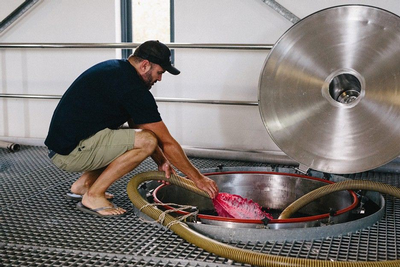
Thorne and Daughters Copper Pot Pinot Noir 2018
- Cape South Coast, South Africa
- Shale and sandstone soils
- Native yeast fermentation
- 60% whole cluster
- 18 days on skins
- No additives other than SO2
- Aged 9 months in neutral French oak
- Raspberry, satsuma, Ceylon cinnamon


Soter Vineyards Planet Oregon Pinot Noir 2018
- Willamette Valley, Oregon
- 100% Pinot noir
- LIVE certified
- Salmon-Safe
- Fermented in small, open-top stainless steel
- Aged in French oak
- Portion of the proceeds donated to the Oregon Environmental Council
- 90 points VM, 90 points WE, 90 points JS
- Dried strawberry, rhubarb, forest floor


Mckinlay Vineyards Pinot Noir 2018
- Willamette Valley, Oregon
- Dry farmed
- Organic viticulture
- Native yeast ferment
- Up to 25% new French oak, depending on vintage
- Unfined, unfiltered
- Wild strawberry, rose, cola

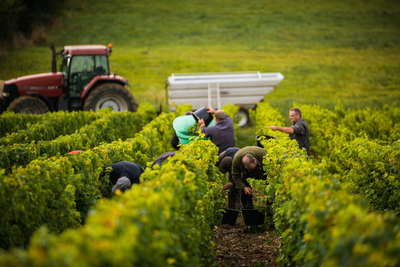
Patient Cottat Le Grand Caillou Pinot Noir 2016
- Loire Valley, France
- 100% Pinot noir
- Clay soil
- 15-20-year-old vines
- 4 ton/acre yields
- 7-day cold soak
- 7-day fermentation
- Cherry pit, bergamot, button mushroom

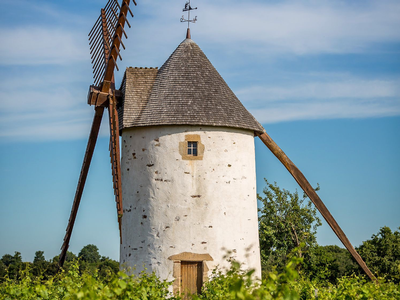
J. Mourat Rouquin de Jardin 2019
- Loire Valley, France
- 100% Pinot Noir
- Certified organic
- Rhyolite, clay, and schist
- Fermented and aged in stainless steel
- Cranberry, red cherry, seaweed


Spy Valley Pinot Noir 2014
- Marlborough, New Zealand
- Clay and silt over gravel
- Handpicked
- Native yeast fermentation
- Fermented in small bins
- Aged 11 months in oak barrels
- 92 points WS
- Raspberry, violet, white truffle
PINOT NOIR 6-PACK, SHOP HERE
Ignite the Beast with these Late Summer Cabernet Sauvignons
IGNITE THE BEAST CAB SAUV 3-PACK, SHOP HERE


Campo alle Comete Cabernet Sauvignon 2016
- Castagneto Carducci, Tuscany
- Alluvial clay
- Fermented and macerated for 3 weeks in stainless steel
- ½ aged in tank and ½ aged in French oak, some new
- 90 points WE, 90 points JS
- Black currant, blueberry, cedar

Jim Barry Cover Drive Cabernet Sauvignon 2016
- Coonawarra, South Australia
- Red loam (terra rossa) over limestone
- 21 year old vines
- Aged 12 months in French oak
- 3.45 ph
- 90 points WE
- Blackberry compote, plum, cola


Smith & Hook Cabernet Sauvignon 2016
- Central Coast, California (San Antonio Valley, Paso Robles, Hames Valley, Arroyo Seco, and San Benito County)
- Barrel fermented
- Aged 10 months in French oak, 60% new
- 3.79 ph
- 91 points WW, 90 points WE
- Black cherry, mocha, vanilla
Italian White Wine 6-Pack Specs & Photos
ITALIAN WHITE WINE 6-PACK, SHOP HERE


Suavia Soave Classico 2018
- Veneto
- 100% Garganega
- 60-year-old vines
- Pergola trained
- Fermented and aged in stainless steel
- Malolactic fermentation
- 93 points JS, 90 points W&S, 17/20 points Jancis Robinson
- Apple, pomelo, green almond


Alois Lageder Terra Alpina Pinot Grigio 2018
- Trentino and Alto Adige
- 100% Pinot Grigio
- Dolomitic limestone
- Mostly pergola trained
- 5-50-year-old vines
- Converting to organic
- Stainless steel aged and fermented
- Aged 4 months on lees
- Lemon zest, sliced pear, mace

Mastroberardino Mastro Greco Campania 2017
- 100% Greco
- Estate founded in 1878
- Calcareous and clay loam
- 20-25-year-old vines
- Stainless steel fermentation and aging
- Yellow peach, citrus pith, mango pit


Umani Ronchi Casal di Serra 2018
- Verdicchio dei Castelli di Jesi DOC Classico Superiore
- 100% Verdicchio
- Calcareous clay
- 8-30-year-old vines
- Hand-harvested
- Fermented and aged in stainless steel
- No malolactic fermentation
- 5 months on lees
- 91 points WE, 90 points Decanter
- Pear, white peach, jasmine


Strasserhof Kerner 2015
- Trentino - Alto Adige, Valle Isarco
- 100% Kerner, a 20th century cross between Riesling and Trollinger that shares many qualities with Riesling
- 10-25-year-old vines
- Sand, clay, and gravel
- Fermented and aged in stainless steel
- Elderflower, apricot, crushed slate


Zenato Lugana San Benedetto 2018
- Lombardy and Veneto
- 100% Trebbiano di Lugana
- Clay loam
- Guyot trained vineyard
- Fermented and aged in stainless steel
- 90 points WE
- Dried apple, crushed mint, blanched almond
ITALIAN WHITE WINE 6-PACK, SHOP HERE
Beasts of the Southern Rhône 3-Pack
BEASTS OF THE SOUTHERN RHÔNE TRIO, SHOP HERE
Terres des Chardons Chardon Marie 2015
- Costieres de Nimes
- Syrah
- Terroir of galets, large river rocks
- Certified organic, biodynamic since 2002
- Native yeast fermentation
- 30 day maceration
- Low to no sulfur
- Blackberry, tar, iron


Chateau de St. Cosme Les Deux Albion 2018
- Côtes du Rhône, villages of Plan de Dieu, Saint Maurice, and Cairanne
- Certified organic
- 50% Syrah, 20% Grenache, 15% Carignan, 10% Mourvedre, 5% Clairette
- Schist soil
- Vineyards trained en gobelet
- 40 year old vines
- Whole cluster fermentation in concrete
- 6 week maceration
- Aged in concrete and wood tanks for 18 months
- Plum, strawberry, scrub brush


Domaine des Bosquets Gigondas 2015
- First mentioned as a vineyard site in 1376
- 65 acres
- 70% Grenache, 20% Syrah, 8% Mourvèdre and 2% Cinsault
- Converting to certified organic
- Native yeast fermentation
- 30 percent whole cluster
- Aged 12 months in oak, 6 months in concrete
- 94 points WA, 93 points WS, 91 points JD
- Boysenberry, violet, licorice


BEASTS OF THE SOUTHERN RHÔNE TRIO, SHOP HERE
On Muscadet...and Deep Summer Deals for Deep Summer Days & Nights

Jo Landron, Muscadet vigneron and prominent moustache owner
On Muscadet...
Muscadet might just be the summer wine. Unlike more aromatic varieties, it shows well with a serious chill. It is always refreshing, low in alcohol, and thirst-quenching. It is also (usually) very reasonably priced, so you can afford a couple bottles to get you through a sweaty summer evening.
Where is it from?
Muscadet is in the far western part of the Loire Valley, north of Bordeaux. It abuts the Atlantic Ocean, which contributes greatly to its maritime structure and salty flavor. Nantes, the nearest city, is a bustling, rainy tech hub that has been called France’s Seattle.
What is it made of?
Melon B., formerly Melon de Bourgogne. For a more thorough history of the grape, including its unceremonious banishment from Burgundy, please refer to this earlier Thief blog.
What does Muscadet taste like?
Melon, a neutral grape, often tastes of orchard fruits such as green apples or pears, with a lean structure built around citrusy acidity. Muscadet’s proximity to the sea causes a distinctly saline, minerally finish that makes your mouth water. Some producers age their Muscadets on lees for extended periods, providing extra weight and creamy autolytic flavors like baking bread (similar to Champagne).
What should I pair with it?
The classic Muscadet pairing is fresh oysters with mignonette, though they provide an excellent foil for nearly any seafood (particularly raw or light preparations). They also play really well with green vegetables, which can be a difficult pairing. Well-made examples pick up some golden weight as they age, allowing them to be paired with richer foods like chicken in a cream sauce or leeks au gratin.
When should I drink it?
Fresh Muscadet is delicious, salty, and quaffable, the kind of wine to drink on your porch tonight. Aged Muscadet can hold for 10 years or more, growing weightier and more complex as the years roll by. So, I guess the answer is, you should’ve been drinking Muscadet this whole time!


Ch. Thebaud, Famille Lieubeau
DEEP SUMMER DEALS for DEEP SUMMER DAYS
Muscadet 3-Pack, SHOP HERE
Chateau de la Ragotiere Muscadet Sevre et Main Sur Lie 2018
Lemon and the lightest texture are lifted by intense acidity and a lively, fresh aftertaste.
- Country/Region: Loire Valley, France
- Appellation: Muscadet-Sèvre et Maine
- Varietal: Melon de Bourgogne
- Vine Age: 25-years old on average
Domaine de la Fruitiere Cru Clisson 2014
Sourced from profoundly granitic soils that are some of the oldest in France, these wines have a lash of savory acidity and remarkable longevity.
- Country/Region: Loire Valley, France
- Appellation: Muscadet-Sèvre et Maine
- Varietal: Melon de Bourgogne
- Vine Age: 50-years old
- Certified organic
- Vinification: Hand-harvested, basket press, natural yeast fermentation in tank
- Aging: 24 months in tank on lees
La Berriere Muscadet Sur Lie 2018
The wine is fresh and has unusual depth and minerality. Thanks to its exceptional terroir, the wine is very floral and will develop fuller flavors with aging.
- Country/Region: Loire Valley, France
- Appellation: Muscadet Côtes de Grandlieu
- Varietal: Melon de Bourgogne
- Vine Age: Up to 60-years old
- Vinification: 7 months on lees with batonnage 1x each month
Vins de Vacances 6-Pack, SHOP HERE
Joseph Drouhin Rully Blanc 2016
A wine full of charm! The color is a beautiful white gold, with a ravishing purity and brilliance.
- Country/Region: Burgundy, France
- Appellation: Rully, Côte Chalonnaise
- Varietal: Chardonnay
- Vinification: Hand-harvested, aged in French oak (20% new) for 6-8 months.
- Certified organic
St. Cosme Little James Basket Press Pays D'OC Blanc 2018
Chateau de Saint Cosme is the leading estate of Gigondas and produces the appellation’s benchmark wines.
- Country/Region: South of France, France
- Appellation: Pays d’Oc
- Varietals: 50% Viognier, 50% Sauvignon Blanc
- Vinification: Stainless steel
Ingrid Groiss Gemischter Satz Braitenpuechtorff 2018
The oldest wine-growing districtus in Austria, the Weinviertel DAC, is where Ingrid Groiss calls home. Hailing from the town of Breitenwaida, in northeast Austria, near the border with the Czech Republic, Ingrid crafts wines expressive of terroir, keeping with her family’s long tradition of winemaking. She is supremely passionate about her wines, with sustainable practices in the vineyard and minimal interference of modern technologies in the cellar.
- Country: Austria
- Appellation: Neiderosterreich
- Varietals: Rare white blend (Chardonnay, Frühroter Veltliner, Grauburgunder, Grauer Vöslauer, Grüner Veltliner, Hietl Rote, Müller Thurgau, Neuberger, Pinot Blanc, Riesling, Roter Veltliner, Rotgipfler, Sämling, Silberweisse, Welchriesling, Wiesse Vöslauer, Zierfandler)
- Vinification: Hand-harvested, 7 hours maceration, 4 months on the lees in stainless steel tanks
Peyrassol La Croix des Templiers Rosé 2019
The name of the estate is the first indication of its long, illustrious past. Located in the heart of Provence, near routes traveled by Crusaders in the early Middle Ages, the Commanderie de Peyrassol was founded by the Knights of Templar who were dedicated to protecting the Crusaders en route to, and in, the Holy Land.
- Country: France
- Appellation: Provence, IGP Mediterranee
- Varietals: Cinsault and Grenache
Domaine de la Patience Rosé Nemausa 2018
This family estate located in the Costières de Nîmes takes its name from a wild, aromatic herb “La Patience” that can be found throughout the vineyard.
- Country: France
- Appellation: Costieres de Nimes
- Varietals: Grenache and Cinsault
- Vine Age: 20 years
- Vinification: Fermentation in stainless steel, aging in concrete vats
- Certified organic
Figuiere Mediterranee Rosé 2019
Over a period of 25 years, the Combard Family has grown Figuière to its current size of 210 acres. Additionally, Figuière produces an entry-level tier of wines called "Méditerranée" using meticulously selected grapes sourced from négociants. The perfecting touches of maturing and blending are carried out in the domaine’s cellars.
- Country: France
- Appellation: Provence
- Varietals: 40% Grenache, 30% Cinsault, 20% Syrah, 10% Cabernet Sauvignon
- Vine age: 10 – 15 years
- Vinification: Stainless steel fermentation
Crushable Wines from Spain and South America
Spanish Wine Trio, SHOP HERE
Descendientes de Jose Palacios Pétalos del Bierzo 2018
About the producer:
Álvaro Palacios (a celebrated producer of Priorat) teamed up with his nephew, Ricardo Perez, a Bordeaux trained enologist, to fulfill his early passion for making great old vine wine from the Mencía grape. Pétalos is made from vineyards scattered across Bierzo’s western border and made for early enjoyment.
Tech notes:
- Region: Bierzo, Spain
- Varietals: Mencía
- Biodynamic practicing
- Vineyards: Located in and around the village of Corullon – a mix of high elevation and lower
- Vine age: 40 – 90 years old
- Soil type: Schist and ~ 30% clay
- Harvested by hand
- Vinification: Fermentation in large oak vats. Maceration 25 days. No fining.
- Aging: Several weeks in new French oak barrique followed by 6 – 10 months in 2nd and 3rd use barrels.

Ulls de Mel Vin Naturel Red 2018
- Region: Penedès, Spain
- Varietals: 90% Tempranillo, 10% Garnacha
- Vine age: Over 40 years old
- Soil type: Predominantly limestone and sand
- Harvested by hand
- Vinification: Fermented with indigenous yeasts. No added sulfites. “Natural” wine.
Bodega Marañones 30,000 Maravedies 2016
About the producer:
Bodega Marañones is located in the DO of Viños de Madrid in the sub-zone of San Martín de Valdeiglesias where the Sierra de Gredos meets the Sierra de Guadarrama. Their vineyards stretch from the steep hillsides at the base of the mountains down to gentler slopes near the valley floor – providing them with a variety of terroirs that capture a more Mediterranean expression of the Gredos. Helmed by Fernando Garcia, who together with Dani Landi, are the creative minds behind Comando G, Bodega Marañones is farmed organically and manually with the assistance of mules due to the steep slopes of their vineyards.
Tech notes:
- Region: Castillo y Leon (Vinos de Madrid), Spain
- Varietals: Garnacha and Morate (approximately 10%)
- Biodynamic and organic practicing
- Vineyards: 650 – 800 meters
- Vine Age: 30 – 70 years old
- Soil Type: Sand and granite
- Harvested by hand
- Vinification: 24-hour cold pre-fermentation maceration. Whole cluster, natural yeast fermentation in stainless steel tanks and oak vats.

South American Trio, SHOP HERE
Garzón Albariño Reserva 2019
- Region: Uruguay
- Varietals: Albariño
- Vineyards: Atlantic Ocean influenced
- Soil Type: Granite and schist (“ballast”)
- Hand-harvested
- Vinification: 3 – 6 months on fine lees in stainless steel

Catena High Mountain Vines Malbec 2017
- Region: Mendoza, Argentina
- Varietals: Malbec
- Vineyards: High altitude vineyard in Maipú, Lujan de Cuyo, Tupungato, and San Carlos
- Vine Age: Up to 80 years old
- Soil Type: Limestone, clay, sand
- Vinification: Fermented in barriques for 34 days. Malolactic fermentation. Aged for 14 months in American and French barriques, 35% new.

J. Bouchon País Viejo 2019
About the producer:
Bouchon Family Wines began in the late 19th century when young viticulturist Emile Bouchon left Bordeaux, France for Chile. Today, Julio Bouchon and his children carry on their 4th generation family winemaking tradition in the Maule Valley.
Tech Notes:
- Region: Maule, Chile
- Varietals: País
- Vineyards: 650 ft.
- Vine Age: 100 year old Gobelet vines
- Soil Type: Granite and sandy loam
- Harvested by hand
- Vinification: Fermented with native yeasts in concrete
Sparkling Wine Style Guide & Info About the 6 Battle Bubbles Wines
BATTLE BUBBLES 6-PACK - SHOP HERE
Sparkling wine labels can be confusing as heck. Traditional method, Charmat method, brut, extra dry, Prosecco, Cava, Champagne, BLAARGH...I just want bubbles in my glass!!! Here’s a handy guide to help you find the right bottle the next time you’re celebrating a promotion, an anniversary, or even a Tuesday.
Traditional Method - The method used for Champagne, Cremant, and other fine sparkling wines around the world. First, the grapes are picked and pressed, just like regular white wine. The juice is then fermented, usually in stainless steel tanks or oak barrels depending on the winemaker’s preference. The highly acidic still wines that are produced are called the vin clairs. These are blended with reserve wine from previous vintages (unless the producer wants to make a single vintage wine) before being bottled with a small amount of yeast and sugar. As the yeast ferments the sugar, it produces carbon dioxide. This trapped CO2 from the second fermentation stays in the bottles. Blammo, we’ve got bubbles.
As the yeasts die, they drop out of the wine and form sediment in the bottle known as lees. The amount of time a sparkling wine spends on the lees has a huge impact on its aroma and flavor, contributing notes of baking bread or roasted nuts which round out and soften the wine.
After the lees are removed through a process known as disgorgement, the wine is dry and still very tart, so a small amount of sugar is often added to balance the wine. This is the dosage, and it determines the finished sweetness of the wine. Brut is the most common level (~12g sugar), but drier styles have become more popular recently, with some producers choosing to forgo this step in favor of brut nature or zero dosage wines (more on that later).
Cava - Spanish (Catalonian) DO that produces traditional method sparkling wines, often based on Macabeo, Parellada, and Xarel-lo. Often excellent quality vs price.
Prosecco - Italian DOC or DOCG in the Veneto and Friuli (northeastern Italy), often produced from the Glera grape (itself formerly known as Prosecco, recently renamed to avoid confusion). Made in the Charmat method, where a wine is refermented in tank, rather than in each bottle as with the traditional method. The lower production cost allows Prosecco to be sold at very reasonable prices.
Sweetness - The sweetness of a sparkling wine is determined by the residual (unfermented) sugar. In the traditional method, the winemaker will often add a dosage of wine and sugar after disgorgement. In the Charmat or tank method, a dosage is often added after sterile filtration.
Here are the sweetness levels for European sparkling wines:
Brut Nature - 0-3g/l. No added dosage, the driest of the dry.
Extra Brut - 0-6 g/l. Not to be confused with Extra Dry.
Brut - 0-12 g/l. The most common sweetness level. Still drinks fairly dry because of sparkling wine’s high acidity.
Extra Dry - 12-17 g/l
Demi-Sec - 32-50 g/l
Dulce - 50+ g/l
If you’d like a sparkler with more perceptible acidity, a drink to pair with a full meal from salad to main course, head for drier climes. If you prefer a softer, fruitier sparkling wine, or you need something to pair with dessert, aim for the sweeter end of the spectrum. Most importantly, taste a range of styles and learn what you prefer. After all, bubbles are about enjoying yourself!
BATTLE BUBBLES 6-PACK - SHOP HERE

Juve Y Camps Reserva de la Familia Cava Brut Nature 2016
- Cava
- 40% Xarel·lo, 30% Macabeo, 20% Parellada, 10% Chardonnay
- Full malolactic fermentation
- Traditional method
- Aged on lees for 36 months before disgorgement
- Brut nature, meaning zero dosage
- Orange peel, white grapefruit, almond

Camp Viejo Cava Brut Rosé NV
- Cava
- 100% Trepat
- Traditional method
- Aged on lees for 9 months
- 9g/l sugar
- 89 points WW
- Raspberry, strawberry, tarragon

Clos Lentiscus Rosé Brut Nature
- Penedes, Catalonia
- 70% Carinyena, 30% Xarel-lo
- Certified organic vineyard
- Zero So2 added
- Native yeast fermentation
- Traditional method
- Unfined, unfiltered
- Brut nature, meaning zero dosage
- Plum, red cherry, jamon

Cleto Chiarli Vecchia Modena Lambrusco di Sorbara 2018
- Lambrusco
- 100% Lambrusco di Sorbara
- Charmat or tank method
- No malolactic fermentation
- 2 months on lees
- 8g/l sugar
- 93 points JS, 90 points WE
- Orange rind, tangerine, ginger

Sommariva “Il Rosa” Spumante Brut Rosé
- Veneto
- 90% Raboso, 10% Pinot Noir
- Clay soil
- Handpicked
- Fermented in stainless steel
- No malolactic fermentation
- Charmat or tank method
- 12g/l sugar
- Raspberry, rainier cherry, lemon basil

Bisol Jeio Brut Rosé NV
- Veneto
- 50% Merlot, 50% Pinot Noir
- Cold maceration for 36 hours
- Cold fermentation for 15 days
- Charmat or tank method
- 10g/l sugar
- 92 points JS
- Cantaloupe, dried strawberry, cherry pit
BATTLE BUBBLES 6-PACK - SHOP HERE
Sweet Summer Sippers 3-Pack
Click to SHOP


Domaine Pichot Vouvray Domaine Le Peu de la Moriette 2018
- Domaine consists of 60 acres of vineyard, all in Vouvray
- Clay limestone
- 25-50-year-old vines
- Pressed, then cold settled for 48 hours
- 80% fermented in stainless steel, 20% in 400l barrels
- Pear, quince, citrus pith


Marenco Brachetto d’Acqui DOCG 2018
- “For those moments of carefree joy” - Wine and Spirits
- Pineto valley
- 100% Brachetto d’Acqui
- Macerated 4 days, then fermented at low temperature until 5.5% alcohol
- No added sugar
- Lightly sparkling
- Strawberry, raspberry, rose petal


Dr. Thanisch Feinherb Riesling 2018
- Bernkastel, Mosel
- Established in 1636
- No insecticides, herbicides, or chemical fertilizers used in the vineyards
- Vinification occurs in 350-year-old “doctorcellar”, a stone cellar carved into a hillside
- Peach, apricot, slate
Click to SHOP
Sicilian Scirocco (Not just a bunch of hot air) & Info on our Etna Whites 3-Pack
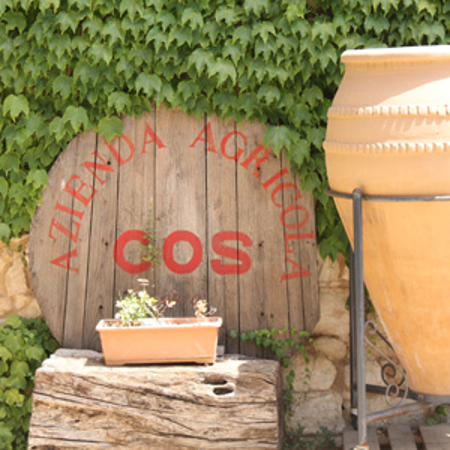
We love the pyrotechnic wines of Mt. Etna, but it would be a shame to forget about the wines from the rest of Sicily. The shop just received a large shipment from one of our favorite Sicilian producers: COS. This is the hottest week of the summer so far, so it seems appropriate to daydream about olive trees, fried eggplant, and spicy wine.
COS was founded in 1980 when three friends purchased an old estate in Vittoria, in southeastern Sicily. At the time, they were the youngest producers in the region. Sicilian wine was just beginning to wake from its post-phylloxera, post-war slumber, and its wines were often marked by a tarry rusticity that is the hallmark of inelegantly made Nero d’Avola. COS quickly established a new paradigm with fragrant, energetic wines based on two local red varieties: Nero d’Avola and Frappato.
Nero d’Avola is the darker varietal of the two. Giusto Occhipinti (the O in COS, and Arianna Occhipinti’s uncle) likens it to Syrah. It has many of the same structural and aromatic qualities, with dark plummy fruit, black pepper, and violets, as well as the ability to retain acidity in Sicily’s warm Mediterranean climate. Frappato is lighter, with red berries (especially strawberry) and intense florality, reminiscent of Cru Beaujolais.
COS bottles several monovarietal renditions of Nero and Frappato, but the varieties really shine when they’re blended. Sicily’s only DOCG, which COS was instrumental in establishing, is Cerasuolo di Vittoria (“cherries of Vittoria”), which must be a blend of 50-70% Nero d’Avola and 30-50% Frappato. Nero d’Avola provides structure and density while Frappato brings lift and aromatic potency. This inherent balance, especially when combined with limestone soils and COS’s attentive organic viticulture, makes for a sun-kissed, unabashedly Mediterranean wine with surprising vivacity and freshness.
Their pursuit of freshness does not end in the vineyard. COS was one of the first wineries in Italy to revive the ancient practice of fermenting and aging wines in unlined terracotta amphora (that’s big clay pots to you and me). The amphoras are neutral vessels that allow the wine’s fragrance to shine without the obstruction of oak, while their porosity provides small amounts of oxygen (as opposed to an anaerobic stainless steel tank).
The wines of COS are distinctive and iconic (much like their squat, old-timey bottles), and they have helped to revive the winemaking industry in Sicily. Fry up some eggplant, boil some pasta, and enjoy a bottle or two as the summer heat shimmers.
Click red names to shop:
COS Pithos Rosso Amphora 2016
COS Cerasuolo di Vittoria Classico 2015
COS Cerasuolo di Vittoria Classico delle Fontane 2012
Azienda Agricola COS Contrada Nero D'Avola 2011

Some of our other favorite Sicilian producers -
Arianna Occhipinti - the student becomes the master. Arianna formed her domaine at 22, after helping her uncle for several harvests. Her wines share many qualities with COS’s, from organic viticulture to cutting edge winemaking. Her Frappato is frankly Burgundian.
Arianna Occhipinti Frappato IGT 2017
Feudo Montoni - a new addition to the shop. Value priced, well-made wines for a Tuesday pasta.
Feudo Montoni Lagnusa Nero d'Avola 2016
Feudo Montoni Vigna del Masso Catarratto 2017
Il Censo - Another organic producer, inspired by Umbrian legend Paolo Bea. Deep, dark, Syrah-y Nero d’Avola perfect for roasted lamb.
Il Censo Provvido 2016
Colosi - a shop favorite, punches well above its price. Screams for anything with grill marks.
Colosi Nero d'Avola 2018
Planeta - wonderfully floral Frappato makes a great red wine pairing for lighter fare, including rich seafood.
Planeta Frappato Sicilia Vittoria DOC 2017
Tasca d'Almerita - Salty, spicy Grillo from near Marsala. A maritime white for squid, shrimp, or even, gasp, green vegetables.
Tasca d'Almerita Mozia Fondazione Whitaker Grillo 2018
Volcanic Etna Whites 3-Pack, SHOP HERE
“Etna is like an immense house cat who quietly roars and sometimes wakes up, yawns, with sluggish stretching and, of a distracted paw, now covers a valley now another, erasing villages, vineyards and gardens. And just as Eliot's cats have three different names: Etna, Mongibello, and the third secret. Immense. " Leonardo Sciascia

Tenuta di Fessina Erse Etna Bianco 2016
- Named for the Greek goddess of dew
- 80% Carricante, 20% Catarratto and Minnella
- Volcanic sand
- 50-100 year old vines
- 3,000 foot elevation
- Fermented and aged in stainless steel
- 91 points WE, 90 points VM
- Lemon, green pear, verbena

Benanti Etna Bianco 2018
- 100% Carricante
- Volcanic sand
- East and South Etna
- Fermented and aged in stainless steel
- 2,000-3,000 foot elevation
- 20-60 year old vines
- Green apple, white flowers, smoked salt

Tenuta de la Terre Nere Etna Bianco 2018
- 60% Carricante, 25% Catarratto, 10% Grecanico, 5% Minnella
- Volcanic sand
- North side of Etna
- 25-60 year-old vines
- Certified organic
- Fermented and aged in stainless steel
- 93 points JS
- Dried apple, preserved lemon, sea spray
SHOP HERE
Walla Walla Valley Summer Celebration Wine Packages
Walla Walla Red Wine 3-Pack, SHOP HERE
Vital Wines Quintessence Cabernet Sauvignon 2017
Vital is a non-profit winery founded by Ashley Trout of Brook & Bull working for better healthcare for vineyard and cellar workers. Many of the materials are donated by Washington state vineyards and wineries.
Time & Direction Syrah 2017
Time & Direction is a boutique, Rhone focused winery run by one-man-show, ex-sommelier, and former Thief employee Steve Wells. His Syrahs have already received high accolades from several wine publications, and he is just getting started.
Prospice Merlot 2017
Prospice Wines consists of the winemaking duo Jay Krutulis and Matt Reilly. Their first shared project was a WWCC Merlot, and now years later they continue to produce fantastic “f@#$@$% Merlot!” Take that Miles.
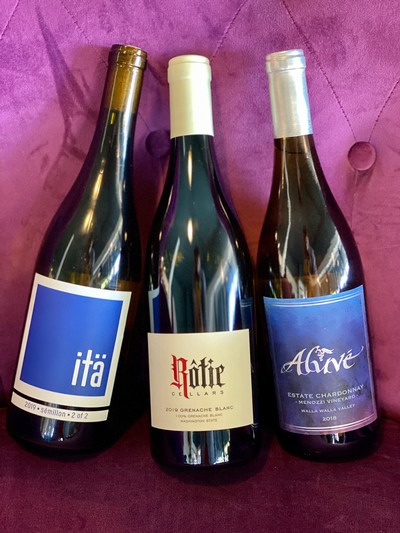
Walla Walla White Wine 3-Pack, SHOP HERE
itä 2 of 2 Semillon 2019
itä Wines is a new winery from WWCC Enology program graduate Kelsey Albro Itämeri. She crafts elegant, balanced wines from high elevation vineyards on Walla Walla’s east side.
Rotie Cellars Grenache Blanc 2018
Rotie’s Sean Boyd has been a driving force in Walla Walla’s Rhone scene for more than a decade, producing wines with power and finesse from some of the region’s finest vineyards.
Aluvé Estate Chardonnay 2018
Kelly and JJ of Aluvé Winery use estate-grown fruit from the vineyard adjacent to their home for this succulent, ripe Chardonnay. After 20+ years in the Air Force, harvest is a breeze.

Celebrate Rosé! Walla Walla 6-Pack, SHOP HERE
Lagana Pinot Noir Rosé 2019
Jason Fox sources the Pinot Noir for his rosé from Breezy Slope Vineyard, one of the highest elevation vineyards in Walla Walla. The elevation helps this notoriously finicky variety hold its acid, making it perfect for refreshing rosé.
Grosgrain Blush 2019
This dry, concrete fermented Grenache rosé from Matt and Kelly Austin is a cheeky nod to the California Blush wines of the past, though it’s done in the light, refreshing house style of this new winery.
Smak Summer Rosé 2019
A local rosé pack is not complete without one of Fiona Mak’s delicious bottles. Her label is rosé exclusive, with releases reflecting the changing seasons. Rosé all year!
Hoquetus Cabernet Franc Rosé 2019
Advanced Sommelier Robert Gomez’s new label, with its striking artwork and thoughtfully crafted wines, has quickly become a shop favorite. He hit it out of the park with this rosé from Blue Mountain Vineyard.
El Corazon Red Frog 2019
El Corazon is a party, and Spencer Sievers is the MC/DJ/disco ball/Winemaker. This Malbec rosé will cool you down like a lake in July. Rbbbbt.
The Walls Cruel Summer Rosé 2019
This blend of Grenache and Syrah from French Creek Vineyard is always one of our favorite rosés, and the new vintage has not disappointed. Consulting winemaker Todd Alexander has produced an aromatic, fresh pink to beat the Walla Walla heat.

